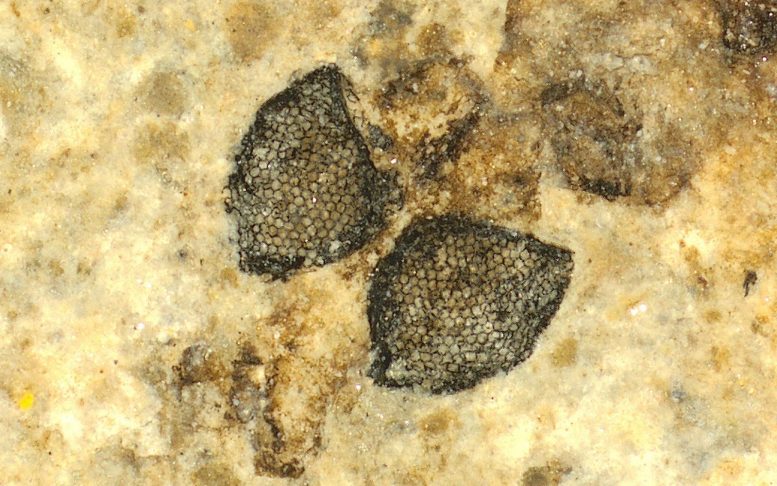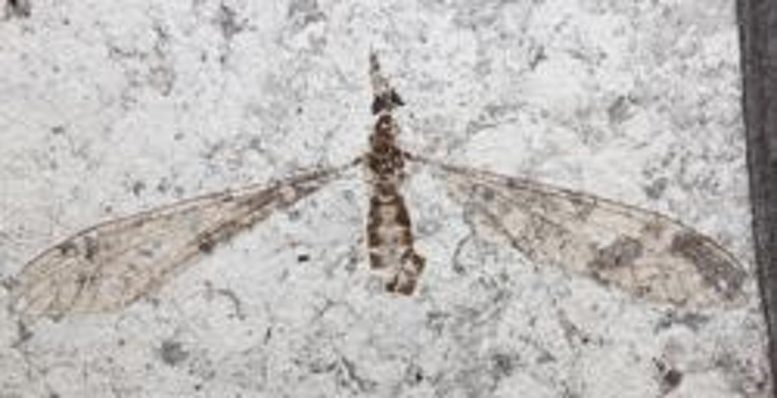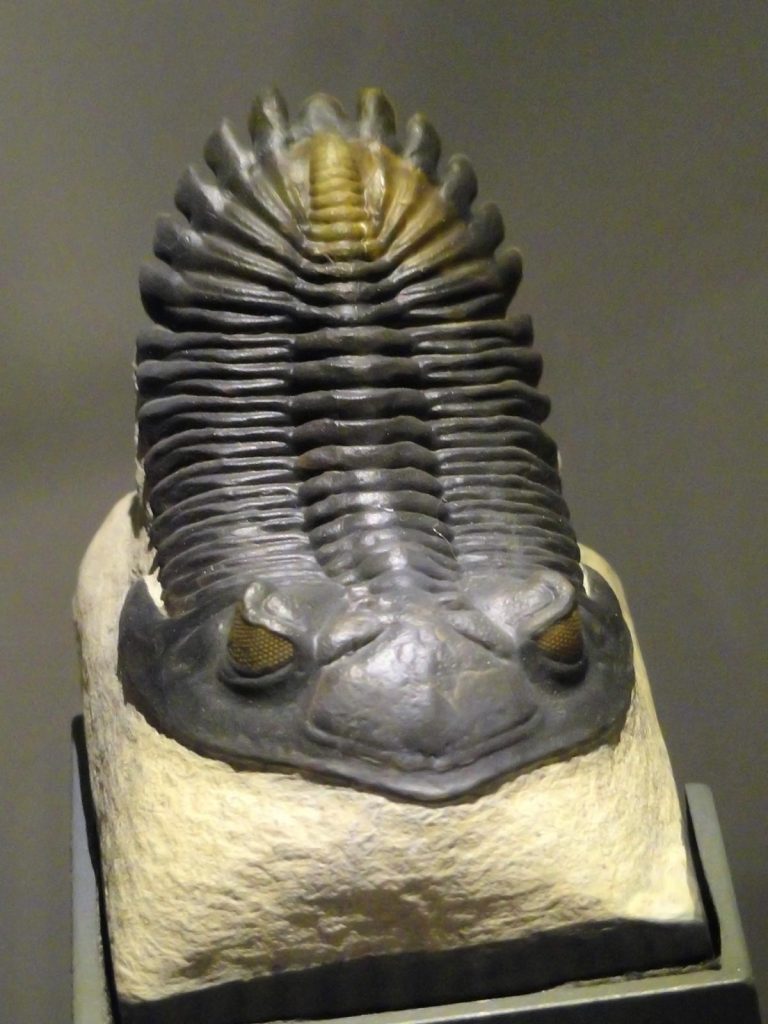
Fossilized flies that lived 54 million years ago have revealed a surprising twist to the tale of how insects’ eyes evolved. These craneflies, unveiled in Nature today, show that insect eyes trap light the same way as human eyes, using the pigment melanin – yet another example of evolution finding similar solutions to similar problems.
Evolutionary biologists have always been fascinated by eyes. Charles Darwin, anticipating the skeptics, devoted a long explanation of how random mutation followed by natural selection could readily fashion such “organs of extreme perfection”. It is not surprising that these useful adaptations have evolved repeatedly across the animal kingdom – octopuses and squids, for instance, have independently acquired eyes uncannily similar to ours.
Vision is so vital that most animals today have photoreceptors of some kind. Notable exceptions include creatures that live in total darkness, such as in caves or the deep ocean.
Yet the fossil record of eyes is very poor. The rock record generally preserves hard parts such as bones and shells. Eyes and other soft tissues, such as nerves, veins, and intestines, are preserved only under exceptional circumstances.

Exceptionally preserved insect fossils
Because eyes are icons of evolution yet rarely fossilized, the discovery of perfectly preserved eyes from 54 million-year-old insects is noteworthy. In their new study, researchers led by Johan Lindgren of Lund University in Sweden collected and analyzed eyes from 23 craneflies – long-legged relatives of pesky houseflies.
The fossils were exquisitely preserved in sediments containing high levels of fine-grained volcanic ash. They were unearthed in what is now chilly Denmark, but back then was a tropical paradise with abundant insect life.
The fossilized eyes were surprisingly similar to our own eyes in one important way. The back of our eyeball, called the choroid, is dark and opaque; this protects against ultraviolet radiation and also stops stray light from bouncing around and interfering with vision. In human eyes, this anti-reflective layer contains high levels of the pigment melanin, the same molecule involved in skin pigmentation (hence terms such as “melanoma”).
Insects, too, have dark anti-reflective layers in their eyes, but this was long thought to consist entirely of a different molecule, ommochrome. Given that insect eyes arose independently from our own and have an entirely different structure, it seems reasonable that their molecular machinery would also be different.
Eyes like our own?
However, detailed chemical analysis of the fossil cranefly eyes revealed that they contained human-like melanin. When the researchers had another look at the eyes of living craneflies, they were surprised to confirm the presence of melanin (as well as lots of ommochromes). It took fossils to alert us that the eyes of humans and insects both use the same shielding pigments (melanin) – yet another example of convergent evolution.
Intriguingly, the outer layers of the fossilized eyes were full of calcite, the mineral that makes up most of limestone. Not only that, but crystals in the calcite were aligned to transmit light efficiently into the eye. Yet this apparent fine engineering (a mineralized outer eye layer optimized to transmit light) was almost certainly caused by the fossilization process, as the eyes of living craneflies are not mineralized.
While the fossil record can reveal, it can also mislead, if not interpreted carefully. Trilobites, the hard-shelled crab-like creatures that are among the most abundant and diverse animal fossils, are frequently found with mineralized, light-transmitting outer eye layers. These have usually been assumed to faithfully reflect their life condition: predation in ancient oceans was so intense that trilobites even armored their eyeballs.

Lindgren and colleagues warn against this interpretation: perhaps the trilobite’s “protective goggles” only appeared after fossilization, just as in the craneflies. However, this interpretation will likely be debated. Trilobite eyes seem to have been unusually rigid and resilient in real life, as they are preserved in three dimensions much more often than eyes of other animals. They also have certain optical properties that make more sense when the rigid outer layer is accepted as real.
A disagreement between a few paleontologists might seem a bit arcane, but these debates can have real-world relevance. Most famously, the concept of nuclear winter was directly inspired by the discussion of how the dinosaurs went extinct, when a meteorite impact enveloped the world in a cloud of dust, deep-freezing the entire biosphere.
Granted, the debate over how insect and trilobite eyes functioned is unlikely to influence world peace, but it might still have useful applications. For example, the way trilobite lenses (apparently) provide constant acuity while being totally rigid has inspired bioengineers to fashion high-performance optical devices with uses spanning microscopy to laser physics.
Reference: “Fossil insect eyes shed light on trilobite optics and the arthropod pigment screen” Johan Lindgren, Dan-Eric Nilsson, Peter Sjövall, Martin Jarenmark, Shosuke Ito, Kazumasa Wakamatsu, Benjamin P. Kear, Bo Pagh Schultz, René Lyng Sylvestersen, Henrik Madsen, James R. LaFountain Jr, Carl Alwmark, Mats E. Eriksson, Stephen A. Hall, Paula Lindgren, Irene Rodríguez-Meizoso and Per Ahlberg, 15 August 2019, Nature.
DOI: 10.1038/s41586-019-1473-z
6 Comments
Great website! Thanx!
Evidence for convergent evolution? Or rather, evidence that does not refute the possibility of intelligent design.
The article cites “random mutations” – but fails to mention that mathematical calculations show that it is mathematically impossible for “random mutations” to create new functional genetic sequences sufficient to create new species. Sorry!
The best explanation for similarities between eyes and other structures is that intelligent engineers who were competent with bio-genetic systems designed similar structures in various creatures.
Design is the best explanation – far better than evolution – because it is observed and known as a fact that intelligent engineers can create new genetic sequences that are functional – it’s observed in Genetically Modified Organisms.
The reason that Flinders University – and others – cling to Evolution is because they are afraid to let go of a failed theory that is their icon.
Alright, you brought it up. Do you have a citation for your claim about a mathematical proof that random mutations can’t “create new functional genetic sequences sufficient to create new species?” Just because you say something is true doesn’t make it so. You should provide support for such claims without being prompted!
Maybe I’m missing something but gravity effects every living thing in earth the same way. You don’t need intelligent design to see there would be common evolutionary constraints and drivers toward similar physical attributes.
Second, humans require pre-existing order to design anything. The orderly human brain must preexist before humans can design . Design requires presexisting order. Intelligent design smuggles in a definition for ‘design’ that is not like human design.
This paper of mine refutes the strange interpretations made in this study…
“Trilobite eyes: Calcified lenses in vivo” (1973) SCIENCE, 179 (4077), pp. 1003-1005.
Photographs were taken through these fossilized eyes, each lens of which are single crystals, formed in vivo. Not later.